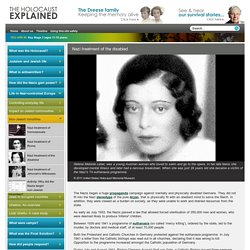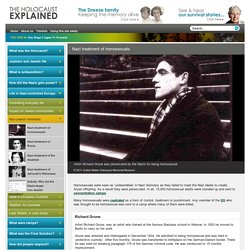

4.4 Nazi treatment of outsiders instructions. 4.4 Homework The badge system for prisoners. Although the symbols worn by prisoners differed from camp to camp, the Nazis used the wearing of badges to differentiate between the prisoners in camps.

Prisoners were also assigned a number which was tattooed onto their skin. The wearing of badges and prisoner numbers signified the absolute removal of human rights of an individual. The badges sewn onto prisoner uniforms enabled SS guards to identify the alleged grounds for incarceration, although these did differ from camp to camp, it’s generally accepted that: Yellow star or triangle – Jewish prisonerGreen triangle – CriminalsRed triangle – Political prisonersBlack triangles – ‘asocials’, (non-conformists, vagrants, the mentally ill), Roma & Sinti (Gypsies – later assigned a brown triangleBrown triangles – Roma & Sinti (Gypsies)Pink triangles – Gay menPurple triangles – Jehovah’s WitnessesBlue triangles – foreign prisoners.
4.4 Homework YOUTUBE Sachsenhausen Concentration Camp. 4.4 Homework DOWNLOADED Sachsenhausen Concentration Camp. Nazi treatment of Roma Gypsies - SCROLL DOWN to the section called Roma. Karl Stojka was born on 20 April 1931.

He was the fourth of six children born to Roman Catholic Gypsy parents in a small village in eastern Austria. The family lived in a horse-drawn caravan. During summers they would travel from place-to-place, whilst they spent winters in Vienna. Karl's ancestors had lived in Austria for more than 200 years. In March 1938, whilst the Stojka’s caravan was parked for the winter in a Vienna, the Germans marched into Austria. In 1943 Karl’s family were deported to the gypsy camp at Auschwitz-Birkenau. VIDEO Nazi Treatment of Gypsies. Nazi treatment of the disabled - SCROLL DOWN. The Nazis began a huge propaganda campaign against mentally and physically disabled Germans.

They did not fit into the Nazi stereotype of the pure Aryan, that is physically fit with an obedient mind to serve the Reich. In addition, they were viewed as a burden on society, as they were unable to work and drained resources from the state. As early as July 1933, the Nazis passed a law that allowed forced sterilisation of 350,000 men and women, who were deemed likely to produce 'inferior' children.
Between 1939 and 1941 a programme of euthanasia (so called ‘mercy killing’), ordered by the state, led to the murder, by doctors and medical staff, of at least 70,000 people. Both the Protestant and Catholic Churches in Germany protested against the euthanasia programme. Fearing a public uprising across Germany, Hitler ordered a stop to the killings. However, the policy continued in one way or another through to 1945. VIDEO Treatment of disabled - Euthanasia (T4) Programme. Aktion T4 - the case of Anna Lehnkering. Nazi treatment of homosexuals.
Artist Richard Grune, was an artist who trained at the famous Bauhaus school in Weimar.

In 1933 he moved to Berlin to carry on his work. Grune was arrested and interrogated in December 1934. He admitted to being homosexual and was held in ‘protective custody’. After five months, Grune was transferred to birthplace on the German-Danish border. There he was tried for breaking paragraph 175 of the German criminal code. After his release, Grune was again held in ‘protective custody’.
Grune escaped during the evacuation of the Flossenbürg camp and joined his sister in Kiel. Richard Grune spent most of the remainder of his life in Spain. VIDEO Nazi Persecution of Homosexuals. CHALLENGE Nazi treatment of Jehovah's Witnesses. VIDEO Nazi treatment of Jehovah's Witnesses.